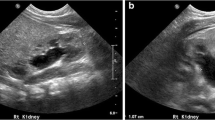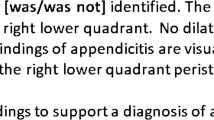Abstract
Background
According to current guidelines, US is the most important modality for imaging urinary tract infections (UTI) in children.
Objectives
(1) To assess the adequacy of paediatric renal US requests and reports in a general radiology department, and correlate the request adequacy and the performing radiologist’s experience with report adequacy. (2) To determine the yield of abnormal findings.
Materials and methods
Retrospective review of renal US requests. The information was scored: requests 0–3 (3 as highest adequacy) and reports 0–21 (21 as highest adequacy). Correlation tests used included Spearman’s correlation, Kruskal-Wallis test, Chi-square test of independence and Fisher exact test.
Results
Mean report adequacy score was 6.67/21. Trainees did 87% of all scans and performed better (score 6.76) than the staff radiologists (score 6.08). Hydronephrosis was the most common abnormality. There was no correlation between request or reporter rank and reporting adequacy.
Conclusion
Renal US requests and reports are inadequate. To improve reporting standards for trainees and specialists, a renal ultrasound reporting template was designed for use.

Similar content being viewed by others
References
Shah G, Upadhyay J (2005) Controversies in the diagnosis and management of urinary tract infections in children. Paediatr Drugs 7:339–346
Biassoni L, Chippington S (2008) Imaging in urinary tract infections: current strategies and new trends. Semin Nucl Med 38:56–66
Riccabona M, Avni FE, Blickman JG et al (2008) Imaging recommendations in paediatric uroradiology: minutes of the ESPR workgroup session on urinary tract infection, fetal hydronephrosis, urinary tract ultrasonography and voiding cystourethrography, Barcelona, Spain, June 2007. Pediatr Radiol 38:138–145
RSNA, Paediatric Radiology Templates: US Peds Renal http://reportingwiki.rsna.org/index.php?title=Pediatric_Radiology(template) Accessed 22 Dec 2010
Lim R (2009) Vesicoureteral reflux and urinary tract infection: evolving practices and current controversies in pediatric imaging. AJR 192:1197–1208
Riccabona M, Avni FE, Dacher JN et al (2010) ESPR uroradiology task force and ESUR paediatric working group: imaging and procedural recommendations in paediatric uroradiology, part III. Minutes of the ESPR uroradiology task force minisymposium on intravenous urography, uro-CT and MR-urography in childhood. Pediatr Radiol 40:1315–1320
Rosenberg HK, Ilaslan H, Finkelstein MS (2001) Work-up of urinary tract infection in infants and children. Ultrasound Q 17:87–102
Kahn CE Jr, Langlotz CP, Burnside ES et al (2009) Toward best practices in radiology reporting. Radiology 252:852–856
Sistrom CL, Langlotz CP (2005) A framework for improving radiology reporting. J Am Coll Radiol 2:159–167
Dacher JN, Lechevallier J (1999) The exam request seen by the radiologist, the report seen by the clinician. J Radiol 80:855–858
Stavem K, Foss T, Botnmark O et al (2004) Inter-observer agreement in audit of quality of radiology requests and reports. Clin Radiol 59:1018–1024
Naik SS, Hanbidge A, Wilson SR (2001) Radiology reports: examining radiologist and clinician preferences regarding style and content. AJR 176:591–598
Nadi HM, Shalan YAF, Al-Qatan HY et al (2006) Urinary tract infection in boys less than five years of age: a general pediatric perspective. Kuwait Med J 38:220–225
Bouskraoui M, Ait Sab I, Draiss G et al (2010) Epidemiology of urinary tract infection in children in Marrakech. Arch Pediatr 17(Suppl 4):S177–S178
Goldman M, Lahat E, Strauss S et al (2000) Imaging after urinary tract infection in male neonates. Pediatrics 105:1232–1235
Langlotz CP (2002) Automatic structuring of radiology reports: harbinger of a second information revolution in radiology. Radiology 224:5–7
Noumeir R (2006) Benefits of the DICOM structured report. J Digit Imaging 19:295–306
Jankharia B (2010) The subspecialization conundrum. Indian J Radiol Imaging 20:1
Strife JL, Ball WS Jr (1998) Research in pediatric radiology: preparing for our future. Pediatr Radiol 28:563–568
Hederstrom E, Forsberg L (1985) Kidney size in children assessed by ultrasonography and urography. Acta Radiol Diagn (Stockh) 26:85–91
Dinkel E, Ertel M, Dittrich M et al (1985) Kidney size in childhood: sonographical growth charts for kidney length and volume. Pediatr Radiol 15:38–43
Muller L, Preda I, Jacobsson B et al (2009) Ultrasonography as predictor of permanent renal damage in infants with urinary tract infection. Acta Paediatrica 98:1156–1161
Blane CE, DiPietro MA, Strouse PJ et al (2003) Pediatric renal pelvic fullness: an ultrasonographic dilemma. J Urol 170:201–203
Chang S, Yang SS (2009) Variability, related factors and normal reference value of post-void residual urine in healthy kindergarteners. J Urol 182:1933–1938
Shaikh N, Abedin S, Docimo SG (2005) Can ultrasonography or uroflowmetry predict which children with voiding dysfunction will have recurrent urinary tract infections? J Urol 174:1620–1622
Kelly CE (2004) Evaluation of voiding dysfunction and measurement of bladder volume. Rev Urol 6 (Supp 1):S32–S37
Author information
Authors and Affiliations
Corresponding author
Rights and permissions
About this article
Cite this article
Govender, N., Andronikou, S. & Goodier, M.D.M. Adequacy of paediatric renal tract ultrasound requests and reports in a general radiology department. Pediatr Radiol 42, 188–195 (2012). https://doi.org/10.1007/s00247-011-2259-0
Received:
Revised:
Accepted:
Published:
Issue Date:
DOI: https://doi.org/10.1007/s00247-011-2259-0




